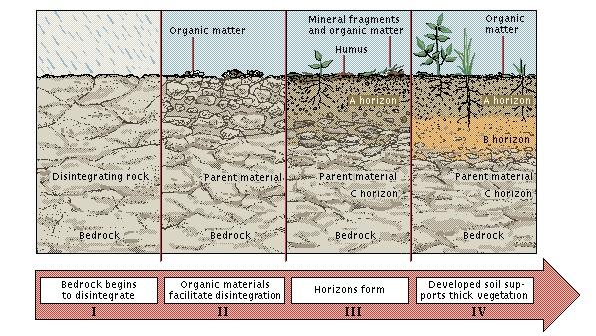Life cycle of a soil
Soils have a life cycle; they are born, mature and become of age. In cases, they may even "die" (disappear or get buried).
Conception
Soil formation starts by disintegrating the rock under the influence of climate. Vegetation settles and their roots further loosen the rock. Decaying plant debris produces organic acids, which further attacks the rock. Organic matter will start to accumulate and be mixed with the mineral material provided by the rock. A soil is born.
Development
Over time, rock minerals will be dissolved or transformed. Elements released from the rock will precipitate and new minerals may be formed. For example, iron will be oxidized and precipitate as iron oxides or hydroxides, giving the soil reddish or yellowish-brownish colours. Soil fauna will settle and mix (‘homogenize’) the soil. The soil will grow in depth through newly formed soil material at the bottom. The soil matures.
Ageing
Given sufficient time under stable biophysical conditions, soils will reach a steady state (equilibrium). Production of humus from decaying organic materials will equal its consumption by soil microbae, fauna and flora. Transformation of rock minerals into soil minerals will keep pace with the removal of earlier formed soil minerals. Slow surface wash of topsoil is matched by new formation of soil material from the bedrock. The soil has aged.
Life hazards
Dramatic events can interrupt the life cycle of soils. A soil may be covered suddenly by a volcanic eruption or by submergence under water. They may disappear in part or altogether by water or wind erosion.
On steep slopes the newly formed loose soil material will be removed fairly easily by runoff of rainwater or gravitational forces. Therefore, soils in mountainous regions are often shallow. On footslopes and in more level areas soil material will accumulate and this leads to deeper soils.
Further, the natural life cycle of a soil may be altered adversely by human-intervention (e.g. compaction or loss of soil organic matter). Hence the need for judicious sustainable land management (SLM) practices.
